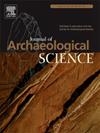红外漫反射光谱法测定陶瓷再羟基化年代
IF 2.5
1区 地球科学
Q1 ANTHROPOLOGY
引用次数: 0
摘要
利用红外漫反射光谱法跟踪水种的去羟基化和再羟基化,为陶瓷测年提供了一种新的方法。在3655 cm−1(OH/H2O), 4550 cm−1(OH)和5160 cm−1(H2O)的水带被用来确定从陶瓷表面和内部吸收或释放的各种形式的水,这允许计算史前羟基的增益,因为制造时间。用梯度温度再羟基化实验(30 ~ 500℃)确定OH扩散的活化能(E)。随后进行了等温扩散实验,该实验提供了高温(240°C)扩散系数,该系数外推到考古温度。这种测年方法的新变体是过去应用的传统质量增益实验的替代方法。我们的陶瓷年代与17世纪美国乔治亚州圣凯瑟琳岛印第安人创造的贝壳堆沉积物中的放射性碳年代一致。本文章由计算机程序翻译,如有差异,请以英文原文为准。
Ceramic rehydroxylation dating by infrared diffuse reflectance spectroscopy
We provide a new approach to the method of ceramic dating by tracking the dehydroxylation and rehydroxylation of water species using infrared diffuse reflectance spectroscopy. Water bands at 3655 cm−1 (OH/H2O), 4550 cm−1 (OH), and 5160 cm−1(H2O) were used to determine the various forms of water absorbed or released from the ceramic surface and the interior, which permitted the calculation of prehistoric hydroxyl gain since the time of manufacture. Ramped temperature rehydroxylation experiments (30–500 °C) were used to establish the activation energy (E) of OH diffusion. This was followed by an isothermal diffusion experiment, which provided a high temperature (240 °C) diffusion coefficient that was extrapolated to archaeological temperature. This new variant of the dating method is an alternative to the conventional mass gain experiments that have been applied in the past. Our ceramic dates are in agreement with associated radiocarbon dates within shell midden deposits created by the 17th century Native Americans on St. Catherines Island, Georgia, USA.
求助全文
通过发布文献求助,成功后即可免费获取论文全文。
去求助
来源期刊

Journal of Archaeological Science
地学-地球科学综合
CiteScore
6.10
自引率
7.10%
发文量
112
审稿时长
49 days
期刊介绍:
The Journal of Archaeological Science is aimed at archaeologists and scientists with particular interests in advancing the development and application of scientific techniques and methodologies to all areas of archaeology. This established monthly journal publishes focus articles, original research papers and major review articles, of wide archaeological significance. The journal provides an international forum for archaeologists and scientists from widely different scientific backgrounds who share a common interest in developing and applying scientific methods to inform major debates through improving the quality and reliability of scientific information derived from archaeological research.
 求助内容:
求助内容: 应助结果提醒方式:
应助结果提醒方式:


